Attentive Listening is not something that many of us allow ourselves the time to do, dominated as we are by a constant flow of visual information, and so mindful of the demands of the clock.
But listening, rather than simply hearing, is an ever-present gateway to hidden worlds of detail and narrative; always close at hand, always available, always possible, requiring only our time, attention and concentration.
Be not afeared; this isle is full of noises,
Sounds and sweet airs that give delight and hurt not.
Sometimes a thousand twangling instruments
Will hum about mine ears; and sometimes voices
that, if I then had waked, after long sleep,
Will make me sleep again; and then, in dreaming,
The clouds methought would open and show riches
Ready to drop upon me,
that when I waked, I cried to dream again.
William Shakespeare, The Tempest.
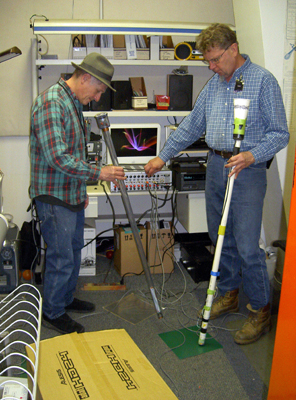
Prototyping the mobile audio induction units at the Exploratorium, May 2006.
Talking-Stick is a beguilingly simple interactive audio work that invites visitors to take a sonic stroll through the Listen exhibition, equipped with a stick-like speaker device to literally seek out a network of hidden sonic narratives. The matrix of sound sources is grouped into several themes that poetically address the act of listening. The themes are broad in scope and approach and range from a series of the Artist’s own ‘sonic memories’ to interviews about the sonic world as perceived by a profoundly sight-impaired person, to an immersion in archival material used in the auditory training of Sonar Operators during WW2.
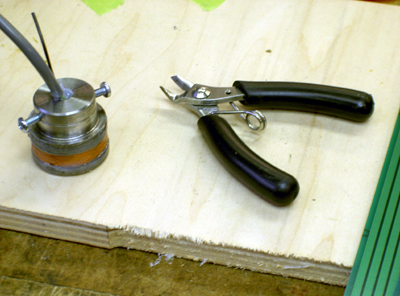
Detail of induction coil pickup.
And here is a sample of an audio project Loup de Loup mostly recorded with EMF antennae made on the Chicago EL (elevated railway which is alive with electromagnetic stuff).
I am one of those rash travellers who refuse to believe in being lost. Rather I prefer to find it difficult to locate myself on the map.
Alone, walking north on the Appalachian Trail, mid-summer in Connecticut. Alone to hear things; even so it’s noisy on this ridge as the chatter of my thoughts compete with my breath. Two, perhaps three days, have passed and I have walked off my maps, by now I must be somewhere in Massachusetts; not a soul in sight. It is raining ~ at least I hear raindrops all around me; yet not a drop has brushed my skin and the sky is as clear as a bell. I close my eyes and listen to the rain only to hear the rumble of an empire of caterpillars as a million mandibles de-foliate the ridge top.
The evening closes in as I descend the ridge, following a lively creek into a miniature granite canyon with moss-encrusted walls and velvet green foliage. I make my camp mindful that I am not the first to do so. The embers finally die and fatigue rises but slumber never arrives. The night is full of voices, the creek speaks in tongues just beyond my comprehension, and conversations pass over me between the vertical stone walls of the canyon as I rest semi-conscious and perfectly safe; sleeping creatures are always protected!
I have listened enough; the following day my supplies are exhausted and I walk off the ridge trail, ambling through farmland until I find a road; roads lead to settlements. Somewhat sheepishly I ask “Please could you tell me what day it is, and where I am, and might I use your telephone…..?”
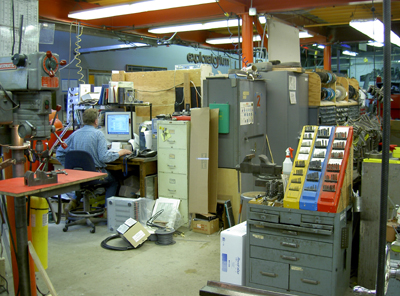
The Exploratorium workshop.
The Visitor experience.
Each visitor will avail themselves of a Talking Stick from an array of various heights, selecting one that matches their own height, placing the small speaker horn mounted at the stick’s upper tip next to the ear whilst the lower tip grazes the floor.
The Talking-Sticks themselves are minimal objects without interface, buttons or instructions ~ the visitor proceeds into the Listen exhibition area, which likewise contains neither clues nor visual markers to identify the location or structure of the sounds. The Talking-Stick is the only guide ~ by slowly sweeping the floor the visitor gradually discovers ‘pools’ of audio at different locations each with a differing sonic narrative.
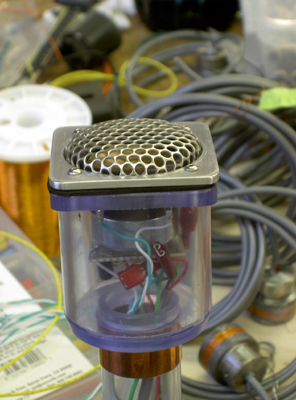
A detail of the Talking stick audio output.
This process is modelled upon spatial memory card games in which participants turn over cards that have been spread face down on the floor, attempting to recall the position of suites of cards. Each visitor shall, in their own fashion, ‘perform’ the work, slowly building up a memory map, and gradually piecing together a spatial network and sonic narrative.
This ‘Sleuth-like’ activity brings together, listening, memory and spatial skills, without the aid of textual reminders or visual cues, activating abilities and faculties we frequently ignore.
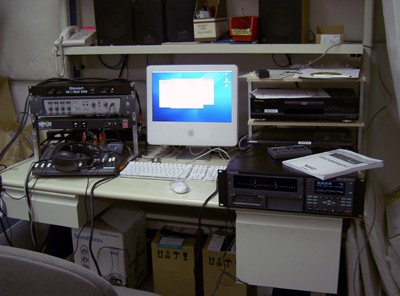
24 track hard drive supplying content.
Nigel Helyer, Sydney 07/04/06